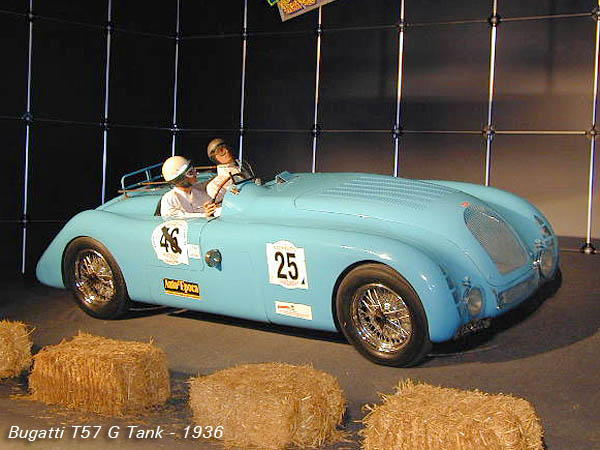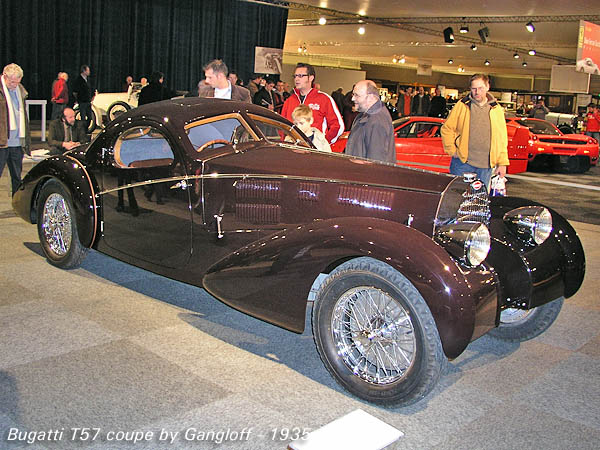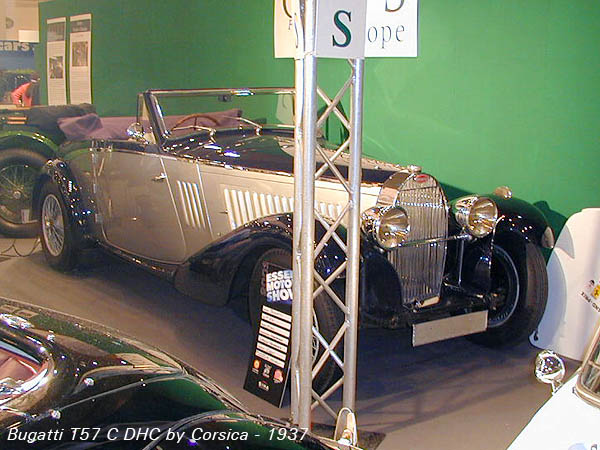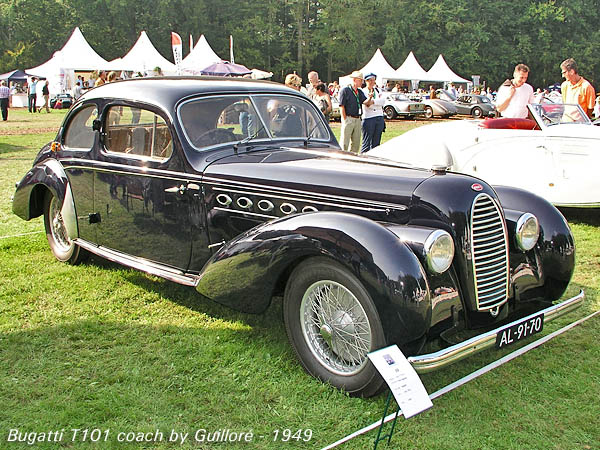Apart from the unified body designs customers could order a Type 57 chassis and have it bodied by their favorite coach builder. There were bodywork options which could be selected out of catalogs from companies like Gangloff or Graber, but when money was no object unique designs by the great contemporary coach builders like Franay, Letourneur & Marchand, Saoutchik, Figoni & Falaschi, Anthem and Van Vooren could be fitted. Results were often stunning, sometimes even bizarre, and it was not uncommon that Jean Bugatti was responsible for the design of these bodies.
 The Type 57 may have been a Grand Tourer but that doesn't mean it wasn't successful in racing. From 1935 Type 57 cars have been used in competition, first with the Grand Raid chassis and later with the short and supercharged S chassis. In 1936 the famous Type 57 G (a lightened S chassis) with streamlined "Tank" bodywork won the French Grand Prix. A year later a similar car won the Le Mans 24-hour race. The last big victory of Bugatti in competition was the 1939 Le Mans 24-hour race with a Type 57 C, a racing car on the long wheelbase chassis with supercharged engine and a Tank-like streamlined body, capable of a 255 kph top speed. After this success Jean Bugatti had a fatal accident when test driving this car. The Type 57 may have been a Grand Tourer but that doesn't mean it wasn't successful in racing. From 1935 Type 57 cars have been used in competition, first with the Grand Raid chassis and later with the short and supercharged S chassis. In 1936 the famous Type 57 G (a lightened S chassis) with streamlined "Tank" bodywork won the French Grand Prix. A year later a similar car won the Le Mans 24-hour race. The last big victory of Bugatti in competition was the 1939 Le Mans 24-hour race with a Type 57 C, a racing car on the long wheelbase chassis with supercharged engine and a Tank-like streamlined body, capable of a 255 kph top speed. After this success Jean Bugatti had a fatal accident when test driving this car.
There were other racing derivatives as well, though some may only have existed on paper. A few Type 57 S chassis were fitted with a Grand Sport body (the traditional cigar-like shape), one or two were fitted with a 4.5 litre Type 50B engine (300-400 hp, dubbed Type 57 S 45) and a streamlined body but were unsuccessful and a Type 57 S 40 (with a 4-litre variation on the Type 50B engine) was planned. A variation on the Type 57 SC engine appeared in the Type 59 Grand Prix car.
This all ensured there was a strong connection between the Type 57 touring cars and Bugatti's illustrious racing heritage, making the touring cars worth their high value.
 Belgian car restorer Bernard Marreyt and his team recreated this amazing Type 57 coupe. It was fashioned after original drawings by coachbuilder Gangloff. This expressive car looks remarkably modern with its low and streaming lines. Belgian car restorer Bernard Marreyt and his team recreated this amazing Type 57 coupe. It was fashioned after original drawings by coachbuilder Gangloff. This expressive car looks remarkably modern with its low and streaming lines.
Apart from producing the standard style Bugatti bodies Gangloff designed and built bodies to order on the Type 57 chassis as well. Some were really extravagant like this adaptation on the Atalante theme, but most were relatively conservative.
 Also British coachbuilders have bodied Type 57 chassis. The best known British bodies on Type 57 chassis were by Corsica (don't let the Southern name fool you), like you see here. It's remarkable to see how Corsica has turned the exuberant French car into a traditional British drophead coupé without compromising the typical Type 57 look. World speed record holder Sir Malcolm Campbell owned a Corsica-bodied Type 57 roadster and claimed it was the fastest and safest series produced sports car on the market. That must have stimulated Bugatti sales in Britain... Also British coachbuilders have bodied Type 57 chassis. The best known British bodies on Type 57 chassis were by Corsica (don't let the Southern name fool you), like you see here. It's remarkable to see how Corsica has turned the exuberant French car into a traditional British drophead coupé without compromising the typical Type 57 look. World speed record holder Sir Malcolm Campbell owned a Corsica-bodied Type 57 roadster and claimed it was the fastest and safest series produced sports car on the market. That must have stimulated Bugatti sales in Britain...
 One final appearance by the Type 57 chassis was made at the end of the 1940s. It formed the basis of the new Type 101, the first Bugatti production car after WW2. Generally regarded as the last true Bugatti it was unsuccessful with only 6 built. One final appearance by the Type 57 chassis was made at the end of the 1940s. It formed the basis of the new Type 101, the first Bugatti production car after WW2. Generally regarded as the last true Bugatti it was unsuccessful with only 6 built.
The Type 101 was available with or without supercharger, offering 140 to about 200 hp. Bodies of all styles by various coachbuilders were fitted on the T101 chassis. This 2-door 4-seater coach body of French coachbuilder Guilloré looks relatively old-fashioned; other T101 chassis were fitted with more modern slab-sided pontoon style bodies.
With the Type 57 everything came together for Bugatti: commercial success, success in competition, acclaimed design, renown agility and driving qualities and excellent workmanship. It also proved to be the end of an era; WW2 had changed the world and the deaths of Jean and Ettore Bugatti had left the Bugatti factory inapt to change with it. Though the factory struggled on for a few decades the Type 57 remained the last car Bugatti was remembered by; the crown on the work of Ettore and Jean.
Today the word Bugatti has become a myth, a synonym for self-willed engineering, artistry and prowess. Qualities which lack in modern day car industry and are sorely missed. Maybe it's best to leave the Bugatti name and heritage as it is, not try to expand on it with new cars, and add more of the Bugatti-spirit into car design.
Credit: portions of the information contained in the text of this tour came from the book "Bugatti: Kunstwerke auf Rädern" by Axel von Saldern, published by Ellert und Richter in 1991 (ISBN 3-89234-218-0).
|
